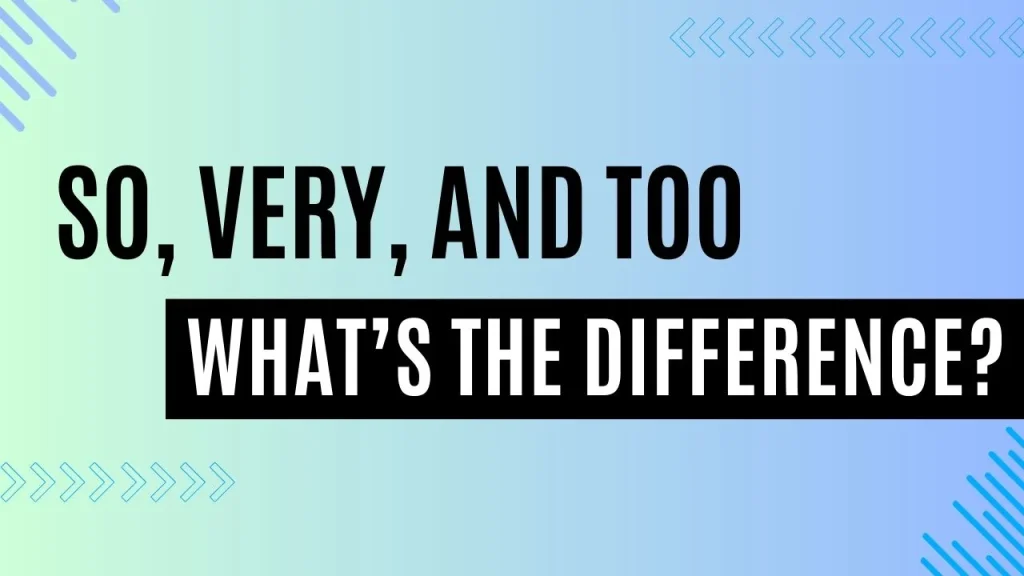
When we speak or write in English, we often want to express or emphasize ideas. Using adverbs such as “so,” “very,” or “too” in a sentence can help us to achieve this goal. However, there are subtle differences among these three words. Being aware of these differences is important to use the words correctly and effectively. “So,” “very,” and “too” can all serve as intensifying adverbs, but each of them has other distinct purposes and can’t be used interchangeably. It is also possible for “so” and “too” to be used as connectors. On the other hand, “very” is just an adverb. So what are the differences? This article will delve into the different meanings and usages of the words “so,” “very,” and “too”.
1. Usage of “So”
A. Emphasizing intensity or extent
“So” is often employed to underscore the degree or magnitude of something. It amplifies the impact of an adjective or adverb, indicating a high level of intensity or extent.
B. Examples of correct usage
- She was so thrilled about the news that she couldn’t stop smiling.
- The concert was so loud that it could be heard from miles away.
C. Common mistakes
Misusing “so” by substituting it for “very” or “too” is a common error. For instance, saying “He was so tired, he could barely stay awake” when “very tired” would suffice.
2. Usage of “Very”
A. Intensifying adjectives or adverbs
“Very” serves to intensify the meaning of an adjective or adverb, conveying a heightened level of the described quality.
B. Examples of appropriate usage
- It was a very hot day, with temperatures soaring above 100 degrees.
- She was very excited to receive the prestigious award.
C. Overuse and alternatives
Overusing “very” can lead to repetitive and dull writing. Alternatives such as “extremely,” “incredibly,” or “exceedingly” can add variety and flair to your language.
3. Usage of “Too”
A. Indicating excess or negativity
“Too” conveys a sense of excess or negativity, suggesting that something is beyond an acceptable limit or undesirable.
B. Instances where “too” is appropriate
- The coffee was too bitter for my taste.
- She worked too hard and neglected her health.
C. Potential ambiguity
Using “too” without clarity on what it refers to can lead to ambiguity. For instance, “The cake was too sweet” could mean it was excessively sweet or unsatisfactorily sweet, depending on the context.
4. Differences and Distinctions
A. Contrasting meanings and contexts
Each of these words carries distinct meanings and usage contexts. While “so” and “very” emphasize intensity or extent, “too” signifies excess or negativity.
B. Examples illustrating the disparities
- “The book was so captivating that I couldn’t put it down” (emphasis on positive intensity).
- “The movie was too long, and I lost interest halfway through” (emphasis on negative excess).
C. Understanding the subtle nuances
Grasping the subtle nuances between these words is essential for precise and effective communication. Paying attention to context and intended meaning can prevent misunderstandings.
5. Practical Tips for Usage
A. Being mindful of context
Consider the context in which you’re using these words to ensure they convey the intended meaning accurately.
B. Alternatives to enhance expression
Explore synonyms and alternatives to “so,” “very,” and “too” to enrich your language and avoid repetition.
C. Strategies for clarity and impact
Prioritize clarity and impact in your communication by choosing the most appropriate word for the desired effect.
6. Common Pitfalls to Avoid
A. Overemphasis or redundancy
Refrain from overusing these words, as it can diminish their impact and lead to redundancy in your writing.
B. Ambiguity in communication
Avoid ambiguity by providing clear context and ensuring that your choice of words aligns with your intended meaning.
C. Misinterpretation due to misuse
Misusing “so,” “very,” or “too” can result in misinterpretation, potentially undermining the effectiveness of your communication.
7. Cultural and Regional Variances
A. Influence of dialects and vernacular
Recognize that the usage of these words may vary across different English-speaking regions and cultural contexts.
B. Varied perceptions across different English-speaking regions
Be mindful of regional variations in the interpretation and usage of “so,” “very,” and “too” to effectively communicate with diverse audiences.
C. Adapting language to suit diverse audiences
Adapt your language and communication style to resonate with the cultural sensibilities and linguistic preferences of your audience.
8. Enhancing Communication Skills
A. Importance of precision in language
Mastering the nuances of language enhances your ability to communicate effectively and connect with others on a deeper level.
B. Strategies for effective communication
Practice clear and concise communication, incorporating varied vocabulary and precise language to convey your message accurately.
C. Developing linguistic fluency
Continuously expand your language skills by reading widely, engaging in conversations
9. Enhancing Communication Skills
A. Importance of precision in language
Mastering the nuances of language enhances your ability to communicate effectively and connect with others on a deeper level.
B. Strategies for effective communication
Practice clear and concise communication, incorporating varied vocabulary and precise language to convey your message accurately.
C. Developing linguistic fluency
Continuously expand your language skills by reading widely, engaging in conversations, and seeking feedback to refine your communication abilities.
Conclusion
In conclusion, the distinctions between “so,” “very,” and “too” may seem subtle, but understanding their nuances is crucial for clear and effective communication. By using these words appropriately, you can convey your thoughts and emotions with precision, ensuring that your message resonates with your audience.